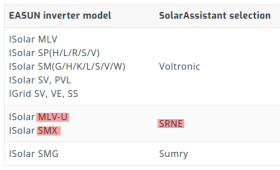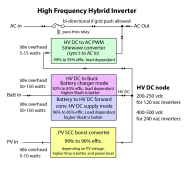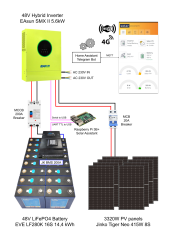EAsun MLV 3KW-U Off grid Hybrid review. 3000W, 120vAC output at either 50 or 60hz. Maximum 100VDc input to 60a MPPT controller. 1400W total Solar. Max 80a AC charging.
I bought this inverter off EAsun’s website under the USA tab at $449 with a 10% off plus free shipping. They did not charge me sales tax. It arrived at my home in just 3 days. So no problem with order or shipping.
Installed it Aug 7th 2022. The setup at the beginning of my trial was:
6-100w solar panels wired 2S3P for around 45Voc
2-100ah AGM batteries wired in series for 24vDC
20a, 120vAC circuit from house system
AC out was to a sub-panel feeding selected loads.
My loads are a 12 cuft upright freezer (no defrost) that has ~70w when running with about 1.4kwh/day
My computer and LTE router setup at about 50w. (It gets turned off after 10 pm back on at 6 am)
The EAsun itself consumes 50w to 100w from what I can figure.
Misc LED lights that get switched on briefly during daytime. Plus alarm clock and security camera video recorder. Probably not more than 30w.
Based on the output panel of the EAsun it seems to run about 1.2 to 1.3 amps at 120vAC
My settings are SBU (Solar →Battery →Utility) for daytime and I manually switch to UTI (utility power preferred - UPS function) about 6-8 pm, I turn the unit back to SBU in the morning about 6 am. I have set my max charge current at 30 amps , and charge from utility at 35 amps. I adopted this practice to minimize battery cycles from nighttime draw.
Because of my forested and south slope location I do not get any appreciable Solar power until about 10 am. This time of year at about 6 pm is the end of watt gathering for the day.
Running in SBU I find that my battery drops to 50% SOC after about 6-8 hours if it is the only supply. It takes most of a full sun day to recharge it while supplying loads. Due to this I tried out just the SOL (solar preferred → utility) setting for a day. I found it resulted in too much switching between utility and solar as things like clouds interrupted production. I can not run the SBU setting overnight without having the battery reach low enough that utility power would have to start charging it. I don’t want the extra battery cycles or the loading on AC.
Some things I found problematic were the display screens of usage and various outputs. They give many outputs in kW instead of watts. Since it only displays two decimal place (0.00kW) it clips off anything less than 10 watts. There is no AC output reading in watts just kVA nor is there any cumulative watts in versus out type display. Would be handy to have a total watt-hr from solar as displayed item. Having to cycle through several screens to get information that should be combined is not the best design.
I also found that I could not set the "Low battery voltage" switch to utility power (#4) to what I wanted using the EAsun “Set” button. It was stuck at 21.8vDC. I had to download a monitor program for my computer from SRNE v1.6 and figure out how to get it setup and connected before I was able to set my desired voltage (24.2v but had to used 12.1v (it doubles) in the program because of how it handles battery settings). I find that the software monitor program is not worth bothering with otherwise. It does not tell me anything in a way I find useful. Not to mention the power needed to keep it operating. (1/28/23 update: Number 4 setting is a pain since it will revert to lower voltage if you change any voltage parameter in the other settings and can not be altered without the external software program.)
Another issue found is LED light flicker when running off of inverter. Did not notice it at first (I was not looking for it) but once I did it is unmistakable. Minor annoyance. Though perhaps major to some people.
Improvements that I made after a few days was to change my solar panel array to 3S2P for higher voltage. (67Voc) This seemed to give more delivered wattage for longer during the day and a higher overall wattage. This Easun MPPT just seems to like a higher input voltage. It does say in the specs that minimum input is 30vDC. With this new arrangement I observed 470w at peak solar time. Whereas with the initial array voltage setup I maxed out at 400w.
I tried running more charging current to the battery from a second MPPT (Makeskyblue) 30a controller connected up to another 2-100w panels and wired to the battery. This caused the EAsun unit to lose MPPT lock and cycle up and down wattage output to zero repeatedly plus give an alarm beep every few seconds*. I discontinued that promptly. If I need more battery charging current from solar I will have to add more panels to the array.
One improvement I would truly love to have in an off grid hybrid AIO would be a system clock with timer settings where you could set it to change from SBU to UTI morning and evening. This would make sense for how solar is generated. Strange that this is not a standard feature for AIO’s. Heck being able to set when the batteries could be charged by utility would help those folks that have a reduced kwh price at certain times of the day.
Overall I am not dissatisfied with how it works. Especially at the price point. I would however consider going to a better quality unit if any of them put in programmable timing. Seems any of the better quality off grid AIO’s are all high KW output and 48vDC which makes them expensive and unnecessary for those that needs that can be handled with less. As to will it last? Time will tell.
* The alarm beep seems to be from the unit detecting solar input and losing it in the early morning. Not noticeable when the Voc was wired lower since it took later in the day to get enough voltage from the sun to engage.
8/14/22 Edit:
Another observation is case fans will run continuously whenever there is a greater than 200w solar input is occurring. It does not seem to matter the temperature.
I bought this inverter off EAsun’s website under the USA tab at $449 with a 10% off plus free shipping. They did not charge me sales tax. It arrived at my home in just 3 days. So no problem with order or shipping.
Installed it Aug 7th 2022. The setup at the beginning of my trial was:
6-100w solar panels wired 2S3P for around 45Voc
2-100ah AGM batteries wired in series for 24vDC
20a, 120vAC circuit from house system
AC out was to a sub-panel feeding selected loads.
My loads are a 12 cuft upright freezer (no defrost) that has ~70w when running with about 1.4kwh/day
My computer and LTE router setup at about 50w. (It gets turned off after 10 pm back on at 6 am)
The EAsun itself consumes 50w to 100w from what I can figure.
Misc LED lights that get switched on briefly during daytime. Plus alarm clock and security camera video recorder. Probably not more than 30w.
Based on the output panel of the EAsun it seems to run about 1.2 to 1.3 amps at 120vAC
My settings are SBU (Solar →Battery →Utility) for daytime and I manually switch to UTI (utility power preferred - UPS function) about 6-8 pm, I turn the unit back to SBU in the morning about 6 am. I have set my max charge current at 30 amps , and charge from utility at 35 amps. I adopted this practice to minimize battery cycles from nighttime draw.
Because of my forested and south slope location I do not get any appreciable Solar power until about 10 am. This time of year at about 6 pm is the end of watt gathering for the day.
Running in SBU I find that my battery drops to 50% SOC after about 6-8 hours if it is the only supply. It takes most of a full sun day to recharge it while supplying loads. Due to this I tried out just the SOL (solar preferred → utility) setting for a day. I found it resulted in too much switching between utility and solar as things like clouds interrupted production. I can not run the SBU setting overnight without having the battery reach low enough that utility power would have to start charging it. I don’t want the extra battery cycles or the loading on AC.
Some things I found problematic were the display screens of usage and various outputs. They give many outputs in kW instead of watts. Since it only displays two decimal place (0.00kW) it clips off anything less than 10 watts. There is no AC output reading in watts just kVA nor is there any cumulative watts in versus out type display. Would be handy to have a total watt-hr from solar as displayed item. Having to cycle through several screens to get information that should be combined is not the best design.
I also found that I could not set the "Low battery voltage" switch to utility power (#4) to what I wanted using the EAsun “Set” button. It was stuck at 21.8vDC. I had to download a monitor program for my computer from SRNE v1.6 and figure out how to get it setup and connected before I was able to set my desired voltage (24.2v but had to used 12.1v (it doubles) in the program because of how it handles battery settings). I find that the software monitor program is not worth bothering with otherwise. It does not tell me anything in a way I find useful. Not to mention the power needed to keep it operating. (1/28/23 update: Number 4 setting is a pain since it will revert to lower voltage if you change any voltage parameter in the other settings and can not be altered without the external software program.)
Another issue found is LED light flicker when running off of inverter. Did not notice it at first (I was not looking for it) but once I did it is unmistakable. Minor annoyance. Though perhaps major to some people.
Improvements that I made after a few days was to change my solar panel array to 3S2P for higher voltage. (67Voc) This seemed to give more delivered wattage for longer during the day and a higher overall wattage. This Easun MPPT just seems to like a higher input voltage. It does say in the specs that minimum input is 30vDC. With this new arrangement I observed 470w at peak solar time. Whereas with the initial array voltage setup I maxed out at 400w.
I tried running more charging current to the battery from a second MPPT (Makeskyblue) 30a controller connected up to another 2-100w panels and wired to the battery. This caused the EAsun unit to lose MPPT lock and cycle up and down wattage output to zero repeatedly plus give an alarm beep every few seconds*. I discontinued that promptly. If I need more battery charging current from solar I will have to add more panels to the array.
One improvement I would truly love to have in an off grid hybrid AIO would be a system clock with timer settings where you could set it to change from SBU to UTI morning and evening. This would make sense for how solar is generated. Strange that this is not a standard feature for AIO’s. Heck being able to set when the batteries could be charged by utility would help those folks that have a reduced kwh price at certain times of the day.
Overall I am not dissatisfied with how it works. Especially at the price point. I would however consider going to a better quality unit if any of them put in programmable timing. Seems any of the better quality off grid AIO’s are all high KW output and 48vDC which makes them expensive and unnecessary for those that needs that can be handled with less. As to will it last? Time will tell.
* The alarm beep seems to be from the unit detecting solar input and losing it in the early morning. Not noticeable when the Voc was wired lower since it took later in the day to get enough voltage from the sun to engage.
8/14/22 Edit:
Another observation is case fans will run continuously whenever there is a greater than 200w solar input is occurring. It does not seem to matter the temperature.
Last edited:








